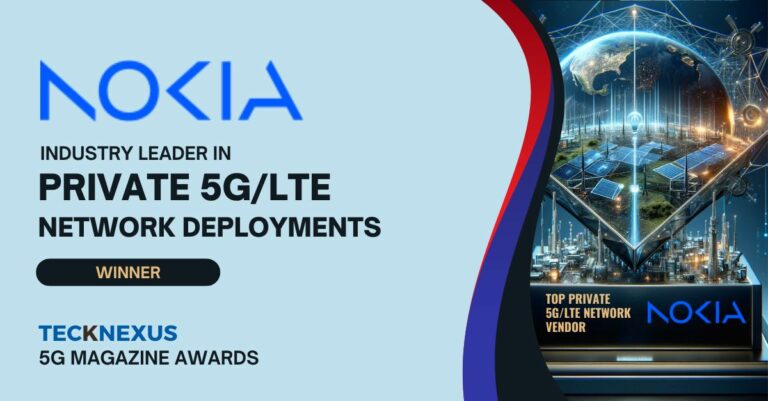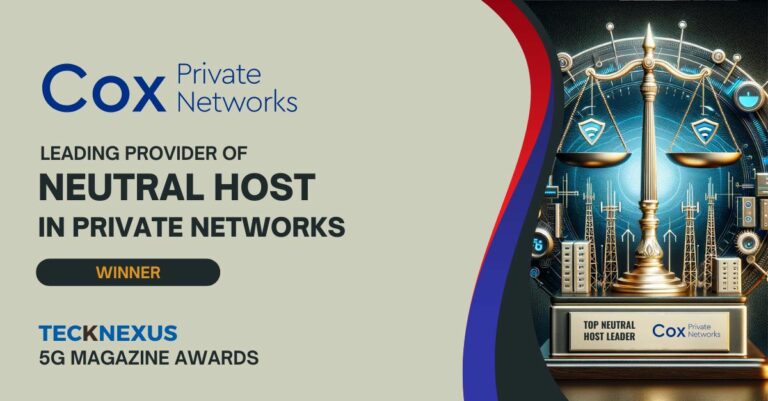When choosing a private 5G network, how do you decide if it is the right choice for your network?
There are several factors to consider when deciding on the most appropriate connectivity strategy for an enterprise. The connectivity needs to be heterogenous, so covering employee mobility and enterprise applications for mobile workers and device connectivity for production. Plus, it also needs vendor and supply chain connectivity. What’s more, the priority for the organization should be based on the business case, and of course, one that delivers a return on investment that makes commercial sense of the new connectivity strategy.
Other factors include the availability of private network connectivity services from MNOs/MVNOs, the availability of free-to-use spectrum like CBRS or delicensed spectrum. Create a collaborative partner ecosystem to leverage diverse expertise, including a primary systems integrator that can help the enterprise evaluate different opportunities and build solutions that can be reliably deployed and can operator on private networks.
What statistics show an increase in the use of private 5G networks or that it is gaining popularity?
According to IDC, the worldwide private LTE/5G infrastructure revenue will reach will $6B in 2024 with 43% CAGR growth for the period 2019 – 2024. There are two key drivers for private 5G licenses: firstly, 5G private networks could offer more autonomy and security. Secondly, some industrial companies are unsure whether telecom operators have the ability to meet their demands and are concerned about delays. 1/3rd of Industrial companies are considering applying for 5G licenses. And nearly half of US industrial companies intend to apply for local 5G licenses, much more than the global average.
Why are private networks becoming possible, and could they emerge as a major trend?
There are many reasons why private networks are growing in importance, especially for certain verticals. Private networks are more reliable and deliver a robust quality of service that meets stringent SLAs. They can be tailored to scenarios like Critical Control Systems in energy production, distribution, or manufacturing and use cases like robotic control.
Security is another key factor why private 5G networks have gained popularity, this can be especially applicable to enterprises, campuses, and of course, the defense sector. Solutions such as geofencing can provide major benefits within private 5G networks.
What makes private 5G networks an attractive option is the ability to use an unlicensed spectrum which evades the license fee overheads you can incur with 4G/5G. While 4G and 5G deliver reliability, thanks to new Wi-Fi technology, connectivity can be secure, reliable, and cost-effective. According to GSA, 185 private networks are already ongoing worldwide. 20% of enterprises believe they need private networks, and 80% of these enterprises have expressed willingness to pay for it.
According to IDC, the worldwide private LTE/5G infrastructure revenue will reach will $6B in 2024 with 43% CAGR growth for the period 2019 – 2024. Evolution of technology in making Private Network-specific NEP (Network Equipment Providers) products that are designed for Enterprise Operations in terms of form factor, ODM friendly supply chains, ease of install and commissioning, zero-touch provisioning, low complexity but high performance within constraints of form factor (using efficient h/w acceleration and software virtualization, etc.)
Private networks are sometimes the only choice in use cases like mining or in remote locations where the telecoms business case for providing widespread coverage is not feasible. Use cases like Remote Smart farming etc. The future of private 5G networks certainly looks promising for several industries globally as governments are promoting the industrial usage of 5G across spectrums by deregulating them.
What will private networks do, and what are their use cases?
There are several use cases. Here is our vision of the major ones:
Monitoring & Control: Connectivity of machines, people, and systems allow manufacturers to have better visibility and control over the status of their production systems, enabling managers to make better-informed decisions and reduce lead times and resource allocation.
Tracking and control: Connecting all sites to evaluate the relative performance of similar processes, implementing a Manufacturing Execution System (MES) to have full traceability and visibility on the status of each production batch to anticipate problems and update schedule, connecting different parts of the supply chain to evaluate global performance and anticipate bottlenecks, providing location-based services to track products and assets, etc.
Predictive Performance & Condition Based Maintenance: Digital simulations of production processes, labs, factories, or entire networks allow companies to steer processes proactively. Predictive analytics technologies will enable us to understand better how input parameters such as machine settings, operator training levels, or raw material options will affect quality and productivity.
Predictive performance: Use of advanced stochastic simulation techniques to model the behavior of the factory and predict performance in changing environments, including new products being introduced, change in product mix, increase or decrease in volumes being applied across new factories, etc. There could also be the use of analytics to understand the performance of individual processes depending on the process parameters and then be able to predict the result (good or bad batch) of the production.
Condition Based Maintenance: Analyze the behavior of individual components in machines and predict when they should be replaced to avoid degraded quality or machine shutdown
Digital Assistance: The shop floor has become increasingly digital, powered by new systems that support operators’ daily tasks.
Augmented Reality: Tools such as Augmented Reality (AR) shows operators the checklist of steps needed to finish specific processes or confirm that required measures have been completed, along with gathering and reporting data to fuel analytical models or guide technicians during the QC process in the lab through the use of augmented spatial reality.
Virtual Reality: Use of Virtual Reality (VR) in immersive environments to facilitate and speed up training for processes in which it is impossible, difficult, or inconvenient to work with the original equipment for example, if you want to train people before the equipment arrives at the site or if they are in a sterile area and do not want people to change clothes for training, or if we do not want to stop production for training. Combination of VR/AR and connectivity to facilitate remote expert support to people operating and maintaining the equipment, applications, and wearables to inform the shift leaders of any significant issue in their area of responsibility.
Worker safety: Ensuring worker’s safety through wearables measuring fatigue, heart rate, breathing, motion, or sensors detecting exposure to smoke or toxic gas and alerting them.
Process Automation: Automating processes in manufacturing, assembly, logistic and transactional activities reduce variability, increase throughput, and reduce operating expenses and inventory. The combination of classical automation with collaborative robots, intelligent vehicles, and robotic process automation delivers excellent results.
This can be the use of Automated Guided Vehicles (AGV), or Automated Intelligent Vehicles (AIV) connected to the MES (Manufacturing Execution System) or EBR (Electronic Batch Record) to handle material in the plant, specifically customized automation of manual processes (usually handling).
Which are the top sectors?
According to GSA, manufacturing is an early adopter of local area private mobile networks, with 51 identified companies holding suitable licenses or involved in known pilots or deployments.
Mining, academic organizations, and ports are also actively trialing local area private mobile networks. Utilities, police, security, public safety, and rail are the biggest users of wide-area private mobile networks. Companies in the communications/IT sector are also key investors in private mobile networks.
Looking in more depth at the manufacturing sector, the automotive subsector is an early leader in terms of private network investment and adoption. Automotive companies account for a third of the 51 identified companies holding suitable licenses or involved in known pilots or deployments.
What are the challenges of 5G networks?
5G networks are facing major challenges.5G industry standards for ultra-low latency are both complex and delayed. 3GPP is expected to address this in Release 17 which is due out in the second half of 2021.
There are some concerns around delays in low-cost devices with 5G native connectivity. Bulk deployment of 5G devices can be an expensive affair due to the limited availability of such devices or because of cost implications. For instance, smart glasses or smart sensors on AGVs or 5G CPE devices and industrial devices may not be readily available in the market with volumes that drive device cost points down. Thus, devices may turn out to be expensive for mass deployment.
As the cost of these features can be high thereby Industrial networks may not migrate from deployed based on Industrial Ethernet and OPC UA etc. for time-sensitive network (TSN) Use Cases of Connectivity.
There are two concerns: 5G-based TSN has only been tested in trials and not in a large-scale factory.
The second concern is about the upgrade of the existing infrastructure in case it doesn’t comply with the requirements of a private 5G network. This could require an investment in new infrastructure and/or replacement of existing infrastructure.
In some parts of the world, there are concerns around 5G Radio-related health and power usage i.e. perceived as not being green. However, 5G has the advanced capabilities of automated network resource management to deliver energy savings to both operators and the enterprise.
Will private 5G hardware work in licensed frequencies, unlicensed, or both?
Yes. There are now innovative private network solution kits from the likes of Ericsson (Industry Connect), Nokia (NDAC), etc. They are created as cloud-native platforms which address specialized radio base station requirements for private network configurations. The radio base station with suitable L1 and L2 innovations can be designed to operate in a range of bands that can be both licensed and unlicensed. Such platforms can combine both data offload and compute at the edge as well as include plug and play functions like Network Core + Software Management. Such platforms deliver flexibility and operational ease. Vendors adopting these solutions will benefit greatly from the enterprise and vertical markets.
How hard will it be to get access to licensed spectrum for private networks?
Licensed spectrum-based Private Networks are services that are launched by MVNOs/MNOs, and the government procedure for having access to unlicensed spectrum for geo-specific radio frequencies is being simplified and is relatively affordable. In the US, the band access to radio frequencies which are designed to be free was also auctioned off, giving priority access (PAL) to CBRS. Several enterprises and telcos have applied for this PAL for CBRS. Thanks to this, private networks in the US could proliferate.
With the arrival of 5G, regulators in many countries and territories are considering or are already allocating more spectrum to enable private network deployment, with the aim of enabling and encouraging digital industry development. Shared spectrum solutions enable the use of the same spectrum range in a single geographic area by more than one organization.
Will private networks be designed and supported in-house? Or will they require specialization from outside companies?
The strategy for private networks is driven by the business rationale and is usually owned by the enterprise CTO, CIO or CNO, etc. As the deployment of a private network requires a specialist, the business would engage a vendor. So, there are a number of opportunities for business consultancy and system integration services. Telecom operators are also offering private networks as a service, and they too engage system integration specialists for geographic or vertical expertise. Thus the operator provides the spectrum and outsources the managed services. Large network equipment providers (NEPs) design and build solutions for 4G/5G private networks and carry out the initial installation. There are already a few enterprise trails underway. To scale a private network, typically the operator would leverage the NEPs infrastructure to meet the needs of the enterprise along with the systems integration specialists.
Will private 5G network capabilities be consistent across regulatory domains?
The connectivity service is delivered over a private network depending on the spectrum band. The mid-band 5G is seen as offering the best mix of broadband access and latency to meet SLAs. Low bands deliver longer geographic coverage and mmWave is low range but can provide high capacity. They can also provide uplink and downlink for low latency and high bandwidth coverage in specific locations.
The nature and type of Private Network Connectivity services will be based on which bands are being deregulated by the country’s regulatory authorities.
How will things for private 5G networks pan out in the next 12-18 months?
Over the past year, there have been several industrial trials of private networks taking place in Europe. We will soon see the business case proof points and the growth in investments to industrialize private network connectivity. So, private networks could expand in the coming months and years.
Some of the trials across verticals such as oil & gas, energy, aerospace manufacturing, etc. slowed down in 2020 and they are likely to pick up in 2021.
Chipset vendors are entering the market this year with a strong SOC portfolio and this is enabling the device ecosystem to be more accessible to vendors and partners who want to enter the private 5G network market. This in turn will help lower the cost for 5G devices and kits, such as like Qualcomm Snapdragon X55 X60 and other companies in this field. Several new NEPs will enter the equipment and solutions market for private networks with software-defined solutions that are off-the-shelf. As such, this space is about to get ultra-competitive.
The CBRS PAL auctions were wrapped up in Q4, 2020. We can therefore expect an uptick in private network trials within the US industrial market. MVNO, MSO, and some large manufacturing industrial enterprises will deploy such networks and create new business cases for private networks. Private networks from hyperscalers are gaining momentum and have already been deployed on some campuses and enterprises.
What challenges are faced in private 5G network implementation?
The market needs products that solve private network connectivity requirements flexibly with a solution that can adapt to the enterprise, without having to be re-engineered completely. This can be achieved with software-based platforms that can plug and play on Layer 1, depending on the 5G band and the type of device connected to the use case. Such solutions can address the business challenge and deliver flexibility for global enterprises which may require product customization.
Each enterprise may face its own unique set of challenges. The technology required could change significantly between different businesses and use cases. The variables can include an enterprise’s location, like the extent of coverage and radio requirements for different sites, the data security considerations may also vary by country and region according to regulations. Then there are the edge compute requirements such as making the decision to deploy all the equipment on-site vs using a shared RAN with common core etc. which can have security and access challenges.
Lowering costs for enterprise 5G networks is a challenge. And there are steps to address this: have a tools-enabled, reliable, and scalable process for private network site design. Have ready-made blueprints and solution templates for certain categories/classes of locations.
Ensure that the network has flexibility in configuration to adapt to site/region needs etc. These can help businesses maximize their investments and significantly reduce delays. A system integration partner with expertise in this area can help smooth the deployment process.
For some enterprises, justifying the business need to have a private 5G network can be challenging. Establishing the use cases, ROI, and business rationale for the investments is an uphill task. To overcome this challenge, the enterprise needs data and performance process optimization to prioritize what services this connectivity can benefit. Having a strategic roadmap of use cases can justify the ROI.
All these aspects can be an entry barrier to CAPEX and OPEX allocation for decision-makers. Having the right consultative systems integration partner can support the enterprises with its life cycle analysis.




























































